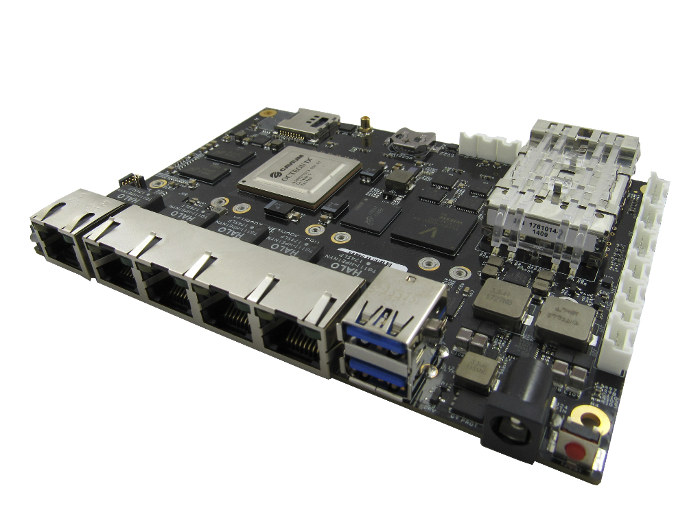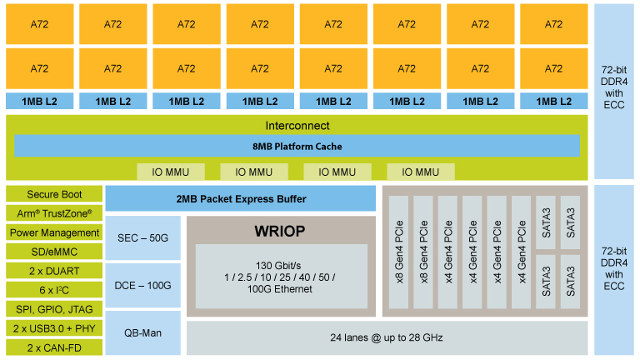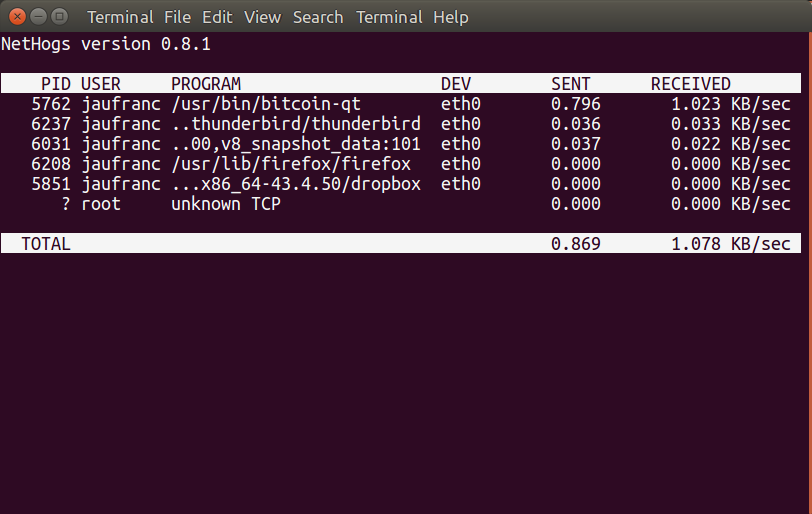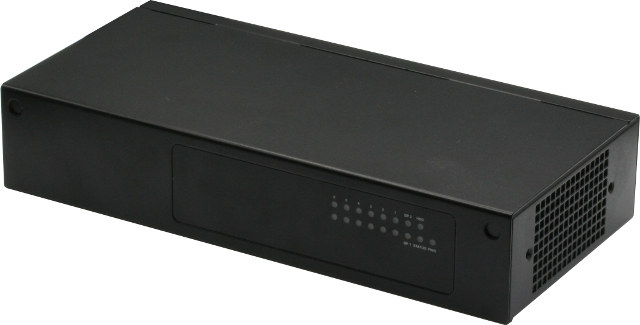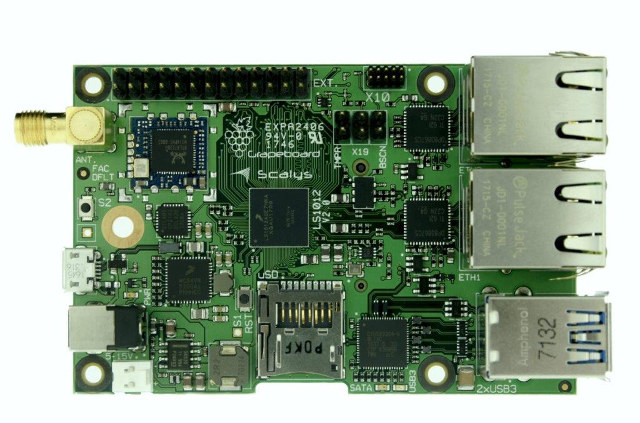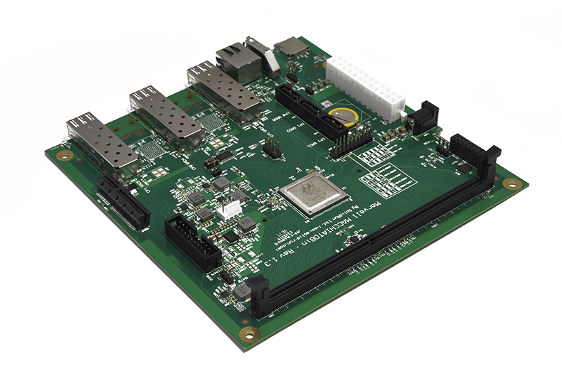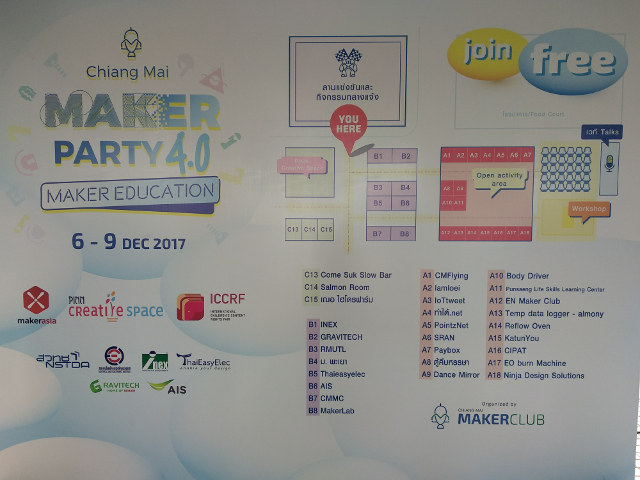Gateworks introduced their Newport SBC family based on Cavium Octeon TX Dual/Quad Core Arm processors at the end of last year, and the company has now announced the availability of the higher end models of their networking single board computers with Newport GW6400 & GW6404, which provide four mPCIe sockets for expansion, five Gigabit Ethernet ports, and in the case of GW6404, two optional SFP cages for fiber connections. GW6400 / GW6404 specifications: SoC GW6400 – Cavium OcteonTX CN8120 dual core processor up to 800MHz GW6404 – Cavium OcteonTX CN8130 quad core processor up to 1.5 GHz System Memory GW6400 – 1 GB DDR4 DRAM GW6404 – 2 GB DDR4 DRAM Storage – 8 GB eMMC Flash , micro SD card slot, serial configuration EEPROM Connectivity 5x GbE Ethernet ports GW6404 – Up to 2x optional SFP fiber ports (redirect of one or two of the RJ45 ports to SFP […]
NXP QorIQ LayerScape LX2160A is a 16-core Arm Cortex A72 Communication Processor with 100 Gbit/s Ethernet
NXP Semiconductors has been working on a high-end communication processor with their QorIQ LayerScape LX2160A SoC equipped with 16 Arm Cortex A72 cores, 16 Ethernet ports supporting 1 to 100 Gbit/s, as well as 24 PCIe Gen4 lanes, and four SATA 3.0 ports. NXP LX2160A key specifications / features: Processor – 16x Arm Cortex-A72 CPU cores, running up to 2.2GHz with 8MB L2 cache, 8MB platform cache Memory I/F – 2 x DDR4 72b including ECC, up to 3200 MT/s, maximum capacity of 256 GB Storage – 4 x SATA3.0 Ethernet Up to 16 Ethernet ports Supported Ethernet speeds include 1, 2.5, 10, 25, 40, 50, and 100 gigabits per second 130Gbps Layer 2 Ethernet switch PCIe – Up to 24 PCIe Gen4 lanes, supporting ports as wide as x8 24 SerDes lanes, operating up to 28GHz Acceleration Engines – 50Gbps security accelerator, 100Gbps data compression/decompression engine Security – Secure […]
Cloudflare Introduces 1.1.1.1 Privacy-focused DNS Service with DNS over HTTPS and DNS over TLS Support
The web is becoming more secure as more and more websites leverage HTTPS, which also improves privacy since the only nodes that know which exact page you are accessing should be your computer/device and the server running the website. If you’re using a search engine, they will also know and potentially get track of your history depending on your favorite search engine. One thing that’s still often unencrypted are DNS requests which convert a website name into an IP address. The servers are also often provided by your ISP, so they may not know which exact page you’ve accessed, but they can still keep track of the websites you’ve visited. Depending where you live, your government may also block DNS servers in your country during “periods of unstability”, so third-party DNS services can be useful. For example, using 8.8.8.8 or 8.8.8.4 from Google, and now 1.1.1.1 or 1.0.0.1 from Cloudflare, […]
Monitor Network Traffic per Process with Nethogs
Yesterday I wrote about using 3G on Raspberry Pi board, and one of the commenter mentioned higher traffic than expected when connecting to 3G to just send a few bytes before disconnecting. One of the reasons are the extra data needed if you transmit data over a secure connection, for example establishing a PPP connection, connect to the board over SSH, and disconnect, results in the transmission & reception of a few kilobytes on my board:
|
1 2 |
Connect time 1.9 minutes. Sent 5815 bytes, received 6972 bytes. |
But if you get much more traffic than that, you may want to investigate if another package may transfer data when it detects the connection is up. To analyze traffic, tcpdump and Wireshark are good options, especially if you want to look into the packets data, however such tools do not tell you which process is sending or receiving the data. So I searched whether I could find a program that would do […]
AAEON FWS-2360 Denverton Desktop Network Appliance Supports up to 6 Ethernet Ports, SATA Storage
Last summer, we started to see products and motherboards based on Intel Atom C3000 series Denverton SoC, including GIGABYTE MA10-ST0 server motherboard and Axiomtek NA362 network appliance with up to 10 LAN ports. AAEON has informed me they’ve launched their own Denverton network appliance with AAEON FWS-2360 equipped with a pair of fiber/copper SFP GbE ports, four GbE ports and two Mini-card slots to accommodate WiFi and 4G LTE expansion. The device also comes with an mSATA socket and a 2.5” SATA bay for storage. AAEON FWS: SoC (one or the other) Intel Atom C3308 dual core Denverton processor @ 1.60 / 2.20 GHz with 4MB cache; 9.5W TDP Intel Atom C3558 quad core Denverton processor @ 2.20 GHz with 8MB cache; 16W TDP System Memory Dual core – 1x DDR4 SODIMM ECC DIMM Quad core – 2x DDR4 SODIMM ECC DIMM Storage – On-board eMMC flash up to […]
Grapeboard Raspberry Pi Lookalike Comes with Dual Gigabit Ethernet, Two USB 3.0 Ports
Scalys is a startup founded in 2016 in the Netherlands by Sintecs in order to provide advanced high-performance embedded system solutions for automotive-, avionics-, defence-, industrial-, medical and telecommunication industries. So the company is rather new, but if you visit their website, you’ll find they already have several systems-on-module and single board computers (SBCs) based on NXP QorIQ processors. Grapeboard SBC is their latest product powered by NXP QorIQ LS1012A (LayerScape 1012A) single core SoC with 1GB RAM, and equipped with two Gigabit Ethernet interfaces, two USB 3.0 ports, an M.2 SATA connector, etc… that make it suitable for IoT applications such as sensor/IoT gateways, communication hubs, and secure edge devices. GrapeBoard specifications: SoC – NXP QorIQ LS1012A single core Cortex A53 processor @ up to 800 MHz with Packet Forwarding Engine System Memory – 1GB DDR3 Storage 64Mb (8MB) SPI NOR Flash for BCD and bootloader, 512Mb/64MB SPI NOR […]
SolidRun MACCHIATObin Single Shot Networking Board Launched for $269 and Up
Earlier this month, I listed SoliRun MACCHIATObin networking board as one of the top 5 most powerful ARM boards in 2017/2018, thanks to its fast quad core Cortex A72 processor, support for up to 16GB RAM, three SATA interfaces, and network connectivity options with several Ethernet copper/SFP interfaces up to 10 Gbps. The problem with powerful boards is that they can be expensive, and the original MACCHIATOBin (Double Shot) board sells for $369 and up. The good news is that SolidRun has just launched a cheaper version called MAACHIATOBin Single Shot with a quad core Cortex A72 processor limited to 1.6 GHz (instead of 2.0 GHz), and the two 10 Gbps interface are only accessibly through SFP cages, and not Ethernet copper (RJ45) ports anymore. MACCHIATOBin Single Shot is based on the same PCB as the original version of the board, and the rest of the specifications are just the […]
A Day at Chiang Mai Maker Party 4.0
The Chiang Mai Maker Party 4.0 is now taking place until December 9, and I went there today, as I was especially interested in the scheduled NB-IoT talk and workshop to find out what was the status about LPWA in Thailand. But there are many other activities planned, and if you happen to be in Chiang Main in the next few days, you may want to check out the schedule on the event page or Facebook. I’m going to go though what I’ve done today to give you a better idea about the event, or even the maker movement in Thailand. Booth and activity area should be the same over the 4 days, but the talks, open activity, and workshop will be different each day. Today, people could learn how to solder in the activity area. The even was not really big with manufacturers/sellers like ThaiEasyElec, INEX, or Gravitech closer […]


